After Oborin’s death on Aug 7, 1944 A.L. Kozhevnikov was Commander of 438 iap for a short two-weeks period till Aug 23, 1944.
By the end of WWII in May 1945, as a Deputy of the 212 giap Commander in the rank of Guard Major, he achieved 25 individual victories (different sources give also 23 or 24 confirmed victories), the last of them on April 18, 1945.
He was awarded Hero of Soviet Union after the WWII on June 27, 1945.

Nov 27, 1944: 438 iap, a part of 205 giad, was renamed to 212 giap,
205 iad was renamed to 22 giad.
April 5, 1945: 212 giap was awarded Alexander Nevskii Order,
May 11, 1945: 212 giap removed from combats,
June 26, 1945: 22 giad (212 giap included) moved to Austria and attached to 2 VA of the "Central Army Group".
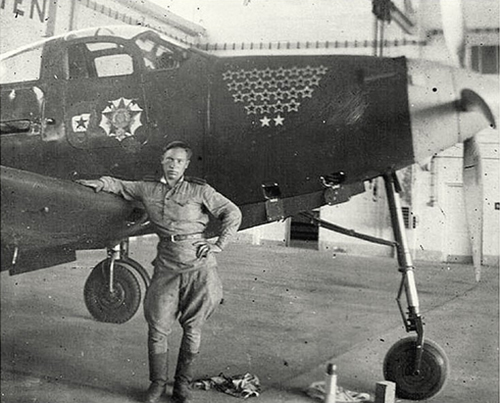
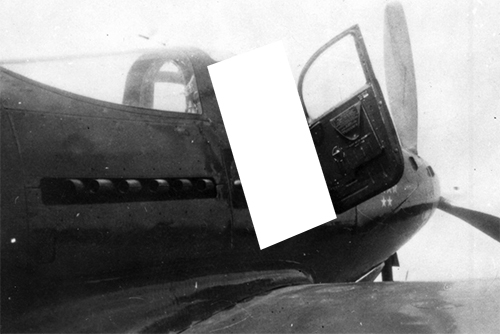
- airplane is dark and glossy, sharp dark reflection of the ground and prop blade on the fuselage are visible. Note regular black waves caused by bended metal surface.
- there is missing black walkway on the wing root outlined by red "no step" line.
- victory stars painted in regular geometrical shape mean that total number of stars were known at moment of painting,
- undersurfaces are very dark, look same dark as uppersurfaces,
- popeller blades are factory painted light grey and highly polished, stencil is visible on the usual place on the bottom blade.
All that supports opinion that this Airacobra was overall repainted, decorated and polished before the military parade or other celebration after the end of WWll. The dark grey is very probable candidate.
While nose is highly polished, the wing root around the wing trailing edge looks semigloss and the paint is scratched and abraded (?) The technician is sitting on the blanked covering wing root.
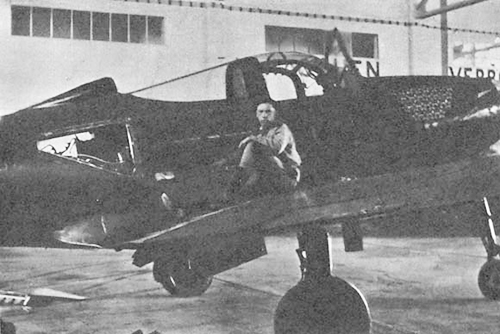
Here are infornations from the book „Song of height“ by T.B. Kozhevnikova, the wife of A.L. Kozhevnikov and then senior technician of the regiment:
November 5, 1943
Pyatikhatki airfield ... a pair of planes taxied in the parking lot. They are scouts/recon. From the cockpit of the first one squadron commander Kozhevnikov: "The plane was shaking as in a fever."
We started inspection - there was a hole through the stabilizer - direct hit ... spar is interrupted, the stabilizer is held only on the casing and the ribs, and the wheel on one hinge...
January 1944
438th Regiment flies to a new airfield in Veselovka... end of February or beginning of March 1944...German bombing raid...we came out from the still hot crater... in fnont of us is mangled aircraft of squadron leader Kozhevnikov, the aircraft that just three months ago came from intelligence with torn a hole in the stabilizer... Squadron commander Kozhevnikov meticulously chose a new aircraft after his previous one was destroyed at the airport under the bombs of the enemy...Kozhevnikov opted the plane with number 38.
February 13, 1945
We flew to a new location - Brig. This is a huge german base airfield. On the distant parking lots around thirty serviceable "Junkers" but with empty tanks, "Messerschmitts" in hangars, inthe warehouses inventory of new tools... for engineering and technical support, the airfield Brig perhaps the most convenient of all, we had based.
early April 1945
The regiment flew to the airfield Lichtenwalde. Actually, this was never airfield. Flat area, bordered on two sides by pine wood.
April 15, 1945
We leapt to the airport Fraiwaldau, and the next day the last major battle of the war started - the Berlin operation.
April 22, 1945
Cottbus, a major city on the highway leading to Berlin is occupied... and probably the last relocation - airfield Dabern.
However, there is not known photo of Kozhevnikov’s P-39 b/n "38". Neither serial number of "38" is known. Plus no known info when/if he switched from "38" to "43". It was almost one and half year untill the end of war - very long time for one Airacobra, they usually survived several weeks, or months at the best. It is possible that 38 and 43 were two different Cobras. Interestingly, the book sais only about "38", but photo shows "43".
An appearance of the fictional „38" can only by guessed, she could look similarly to Oborin’s P-39 b/n „5“. The font of the number „38“ could look similarly to „5“.
A.L. Kozhevnikov wrote 3 books of memoirs. His first book „Fighter diary“ (Zapiski istrebitelya) was published in 1959. This book ends with Victory-day, May 9, 1945 and there is no relevant info about his Cobra(s) is in this book.
Little details about the period after the Victory day are mentioned in his second book „Startuet muzhestvo" published in 1966:
May 09 to June 26, 1945
Dabern airfield...Every plane was checked. Soldiers-artists lovingly painted regimental orders/medals on the fuselages.
June 26 to June 27, 1945
Tuln airfield, near Vienna, Austria...All aircrafts of our Guard Yaroslavl Alexander Nevsky Order fighter regiment were put into large hangars...pilots and technicians went together to make common photos at their fighter planes.
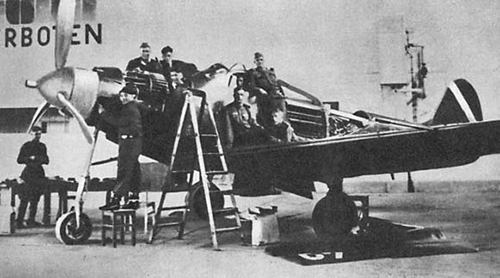
On the photo above the digit behind 4 has "open" left side, is rounded on the top and there is a dent at the top of it. This dent probably indicates thin vertical line across the number – in this case number 3. Most probably the number 43 on Kozhevnikov's Airacobra was sprayed over the stencil.
Board number 43 is correct also according to the info from VIF forum. There is verbal info even about a little number "43" somewhere bellow victory stars, but no publicly known photo confims it.
The photo is heavily retouched so „colors“ on it are very questionable. However, 212 giap used blue spinners as a fast recognition marking. Blue color could have been the light blue like on the spinners of the Cobras from 30 giap http://lend-lease.airforce.ru/english/photogallery/30giap/page_06.htm (note yellow number 93 vs. light blue spinner):
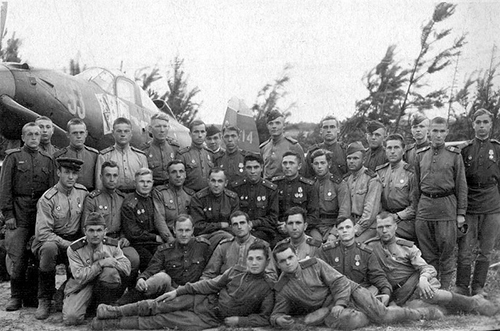
The text from „Istoriya Aviatsiyi“ 2004-1 by Aleksey Pekarsh about 213 giap markings (from the same 22 giad as 212 giap):
"...508 iap...P-39N-1, N-5 ? Q-5... big white board numbers (paint by brush over stencil) on the front fuselage... their style and and way of application kept until the end of war... B/n of the 1st squadron started with 1, b/n of the 2nd and 3rd squadron started with 2 and 3... US Serial on the tail were repainted rarely, usually after overahul... In the autumn 1944 508 iap war rearmed with new P-39Q-15, now b/n of the individual squadrons started with 7,8 and 9, command flight had 100, 101 and 102... That time Cobras (mix of Q-15, 20 and 25) from already 213 giap...Guard badge on the right door. Plus white color from the sprop. spinner war extended to the nose fuselage...From spring 1945 A. Nevsky badge on the left doors... At the end of war they stopped to repeate b/n from lost planes onto new replacements, but they continued with the actual numbers, resulting to many unsusual 3-digits board numbers... After 2013 giap was ordered by Bogdan Khmelnickij order, they again repainted badged on the doors - small Guard badges were on both left and right doors and both orders (Nevskij and Khmelnickij) were placed adjacent on the sides."
White diagonal stripe was fast recognition marking for 22 giad. However, many photos from that era show the diagonal stripe on the P-39 tails from 212 giap in the color different from white. There are testimonies about yellow color.

Let me thank to Alex and Owl-99 from VIF and to Massimo and especially to KL from sovietwarplanes.com for their comments and help.
References and sources of the photos:
http://www.vif2ne.org/nvi/forum/0/0.htm (VIF)
www.sovietwarplanes.com/board
http://www.airaces.narod.ru/all3/kozhevnk.htm